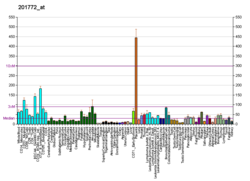| AZIN1 |
|---|
|
| Available structures |
|---|
| PDB | Ortholog search: PDBe RCSB |
|---|
|
|
| Identifiers |
|---|
| Aliases | AZIN1, AZI, AZIA1, OAZI, OAZIN, ODC1L, antizyme inhibitor 1, AZI1 |
|---|
| External IDs | OMIM: 607909; MGI: 1859169; HomoloGene: 22933; GeneCards: AZIN1; OMA:AZIN1 - orthologs |
|---|
| Gene location (Human) |
|---|
 | | Chr. | Chromosome 8 (human)[1] |
|---|
| | Band | 8q22.3 | Start | 102,826,111 bp[1] |
|---|
| End | 102,893,864 bp[1] |
|---|
|
| Gene location (Mouse) |
|---|
 | | Chr. | Chromosome 15 (mouse)[2] |
|---|
| | Band | 15|15 B3.1 | Start | 38,487,671 bp[2] |
|---|
| End | 38,519,510 bp[2] |
|---|
|
| RNA expression pattern |
|---|
| Bgee | | Human | Mouse (ortholog) |
|---|
| Top expressed in | - bronchial epithelial cell
- ventricular zone
- epithelium of nasopharynx
- ganglionic eminence
- epithelium of colon
- cartilage tissue
- placenta
- bone marrow cells
- jejunal mucosa
- body of pancreas
|
| | Top expressed in | - fetal liver hematopoietic progenitor cell
- atrioventricular valve
- barrel cortex
- spermatocyte
- decidua
- lacrimal gland
- atrium
- epithelium of lens
- spermatid
- salivary gland
|
| | More reference expression data |
|
|---|
| BioGPS | 
 | | More reference expression data |
|
|---|
|
| Gene ontology |
|---|
| Molecular function | - ornithine decarboxylase activator activity
- protein binding
- catalytic activity
- ornithine decarboxylase activity
| | Cellular component | - cytosol
- nucleus
- cytoplasm
| | Biological process | - polyamine biosynthetic process
- positive regulation of polyamine transmembrane transport
- regulation of cellular amino acid metabolic process
- putrescine biosynthetic process from ornithine
- positive regulation of catalytic activity
- negative regulation of protein catabolic process
| | Sources:Amigo / QuickGO |
|
| Orthologs |
|---|
| Species | Human | Mouse |
|---|
| Entrez | | |
|---|
| Ensembl | | |
|---|
| UniProt | | |
|---|
| RefSeq (mRNA) | NM_001301668
NM_015878
NM_148174
NM_001363010
NM_001363011
|
|---|
NM_001363012
NM_001363013
NM_001363014
NM_001363024
NM_001363083 |
| |
|---|
NM_001102458
NM_001301688
NM_018745 |
|
|---|
| RefSeq (protein) | NP_001288597
NP_056962
NP_680479
NP_001349939
NP_001349940
|
|---|
NP_001349941
NP_001349942
NP_001349943
NP_001349953
NP_001350012 |
| |
|---|
NP_001095928
NP_001288617
NP_061215 |
|
|---|
| Location (UCSC) | Chr 8: 102.83 – 102.89 Mb | Chr 15: 38.49 – 38.52 Mb |
|---|
| PubMed search | [3] | [4] |
|---|
|
| Wikidata |
| View/Edit Human | View/Edit Mouse |
|

















